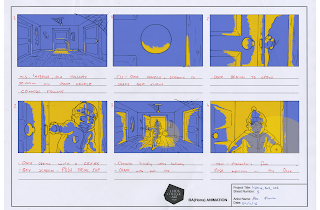I also had my responses from Ryan Adams this week, which was a contact which Drew Roper supplied me with, which were incredibly insightful. Here are the responses, with my own questions on top. I decided to add my own personal questions, so that I could better tailor my practical to fit the needs of a storyboard artist.
- What is your first step when being handed a script to storyboard? I read the script thoroughly. I underline any potential sticking points and note any questions I may have for the Director, then I begin to thumbnail the parts that are more difficult to imagine. Its a interesting part, as this is the beginning of mapping out the entire scene/episode.
- What kind of considerations do you take into account when story-boarding on different projects? I consider style, pace, mood and the actions/behaviour of the characters involved and how they would move across the imagined world. Communicating with the Director and Producers is pivotal to the end result. As this will gather vital information on what shots will capture the vision.
- Do you think any of these considerations differ between an animated project and say a live action project? If you take into account all of the above with an injection of patience and a steady head, then personally, no.
- Do you take into account camera lenses at all when story-boarding for a project? In my own experience, I use arrows and industry standard shots to realise the story. If your shots and movements are clear, then the lenses will talk through the visuals.
- On any project how much of the shot framing/shots in general do you have control of? and How much comes from the Director? The first pass is all on you. Then after that, it gets picked apart. After the notes, then it gets taken off the original board artist and passed onto the revisionist, who will amend any shots in-house. This is a cliché piece of advice, but it bodes well not to get attached to the board that you send, as that board will never come back the same.
Your own Questions:
- What things could I be working on this final year of University to make my portfolio the best possible? You could perhaps pick a scene from a book you like, or a story of your own, and board it. Something that hasn't already been realised. It doesn't have to be a full board, but a scene. Sketching live in public and gesture drawing will serve you in good stead. As a board artist, it is handy to be able to draw fast. I am happy to look at your folio anytime.
- What kind of events could I be engaging with to up my profile as a storyboard artist for after University?Annecy is a good place. CTN also, but that is more adrift. You could also try looking at local meet ups , sketch groups and Animation/ Film festivals. LinkedIn industry users post regular recruitment events. These are good for portfolio reviews.
- Do you think 3D software is a recommended asset in my portfolio as a storyboard artist? I personally don't use 3D Software, but I have heard that it can be useful. I don't think there is any harm in having 3D knowledge, it would be an asset to any studio.
- Is there any sort of Intern/Work opportunities that you would recommend applying for or engaging with which could help me take my first step towards becoming a professional in the Industry? I would email every animation studio that you are willing to go to. Ask them if they have the time to look at your boards and offer up some feedback. Even if 1 gets back out of a 100. Then that is a good result. At least you are on the radar and actively looking. The industry is starved of good board artists. Every studio I have been in, have struggled to gather a team for production. So keep that in mind.
This week I also got on well with my practical and it's development. I have made a storyboard for lighting this week, testing the different methods of shading and how it affected the mood, as well as how readable the board was in general.




No comments:
Post a Comment